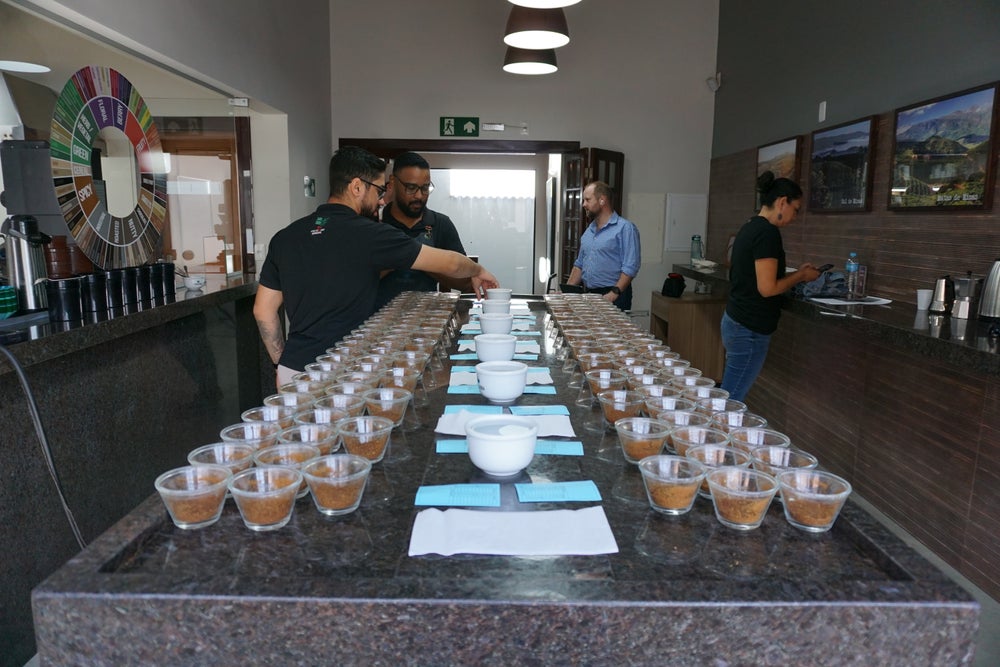From the Field, New Arrivals
Monday, September 12, 2022
Sourcing & Calibrating in Brazil
Our global team works together to bring you the best Brazilian coffees each year, and this year is no exception. Danner Friedman (North America), Carl Sara (Asia Pacific) and Maria Barquin (Europe & Middle East) recently visited the Brazil team, including Specialty Managing Trader, Hugo Portes, in our Varginha offices in Brazil to cup together, discuss our sourcing strategy and book fresh crop coffees for the 2022/2023 year. We caught up with all four of them to learn more about our sourcing strategy in Brazil and how we do such a good job at staying calibrated across vast distances.

Identifying Specialty Coffees
Hugo joined our team in June this year and he’s working hand-in-hand with the team to make continuous improvements in the way we source great coffees. “We decided to break down the walls between our specialty and commercial QC teams. Instead of cupping our coffees in different rooms, we wanted to cup all the offered coffees on the same table, together,” Hugo says. As a result, every coffee now has 3 to 5 people evaluating it, rather than just 1 or 2. Furthermore, this collaboration helps the team identify suppliers with the potential to produce specialty coffee who may have been classified as commercial. “The blurred line is important to help us find new opportunities for great coffees,” Hugo says.
Clear communication with suppliers is also important, Hugo says. “We made sure to visit our suppliers and invite them to calibrate with us. I wanted to start an open conversation about the coffee itself. I think communicating directly about profiles with suppliers should be a yearly protocol,” Hugo says.
Whole-Harvest Buying Benefits Everyone
In addition to better communication, Hugo has helped the team continue to focus on whole-harvest buying. “Our strategy is to buy most of a farmer’s crop,” Hugo says. Top-quality lots will be highlighted as microlots that preserve full traceability back to the farm. The remainder of the lots that pass our QC standards will be incorporated into our popular blends, like our Sucafina Originals Cascavel Verde and Vermelha and Diamond.
This buying strategy accomplishes a number of things at once. Farmers have a market for all their coffee, and they receive strong prices for their harvest, along with fair premiums for the microlots. Roasters get access to both high-quality microlots and affordable, consistent blends. On the whole, the coffee supply chain is made more economically sustainable since farmers are making a livable income and have assured buyers for their whole production, not just the very top lots.
QC Sensory Trainings
Another essential aspect of a strong QC team is continuing education. So far, Hugo been able to run 2 sensory trainings with the Brazilian QC and trading teams. The trainings covered a variety of sensory aspects including a section on identifying and naming types of bitterness and sweetness. A separate section covered defects and introduced the Brazilian trading team to the unique taste of extremely fresh crop coffees. The QC team regularly cups extremely fresh coffees, but the trading team and destination offices rarely do. “With super fresh coffees, you have to parse out the defects from the super freshness and see the potential more than just the existing flavors,” Hugo says. “It was fun to see the traders experiencing that for the first time.”
When cupping, the team is also thinking about how they can communicate with cuppers from other regions. “We have visitors who will come here and say ‘this tastes like wild blackberries.’ But we’re in a tropical climate, we don’t have blackberries here,” Hugo says. He’s looking forward to using the new CQI flavor kits to help cuppers across the globe standardize their descriptions.
Team Calibrations
When Danner and Maria visited Brazil in early August, they cupped with the local Brazil team. “We spent a full day cupping and calibrating with our Brazilian team in their lab. We did everything from redefining the profiles for our Sucafina Original Cascavel lots to evaluating microlots we may want to buy. We cupped over 60 coffees that day,” Danner says. The value of being in the room together, Danner says, is that they could hone their blend profiles and discuss their buying for the year.
“Calibrations help us remain flexible and taste the flavor of the crop,” Hugo says. Since coffee is an agricultural crop, tastes change from year to year and lot to lot. Staying calibrated between teams enables our origin offices to select and blend the best lots to maintain our consistent, blended profiles and best meet the expectations of our clients.
Microlots from Mantiqueira Mountains
Now is the time to start thinking about your Brazilian coffees. Hugo and the Brazil team are hard at work sourcing excellent coffees from across Brazil. One region Danner and Maria are especially excited about is Mantiqueira Mountains.
We’ve written about this region in the past and it continues to be a microlot-producing powerhouse. Unusually for Brazil, most farms in Mantiqueira Mountains are small – just a few hectares – and most harvesting is done by hand. The high altitudes and nutrient-rich soils create superb growing conditions that, combined with a growing focus on specialty processing, help growers produce excellent specialty coffees.
“Microlots from Brazil make a unique offering for your pourover or drip offerings,” Maria says. “So many people know that Brazil produces coffee, but they don’t get to taste single-origin Brazilian coffees very often. Talking about how this coffee is contributing to a growing movement of smallholder specialty coffee producers in the mountains of Brazil is a great conversation starter about the coffee supply chain.”
There’s still time to book your microlots, so get in touch with your trader today to get samples and start planning your coffee program.